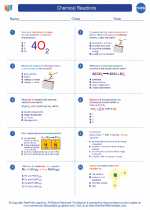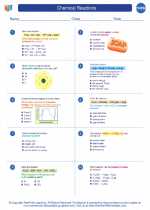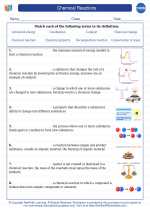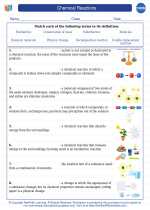Single Replacement Reaction
A single replacement reaction, also known as a single displacement reaction, is a type of chemical reaction in which an element reacts with a compound and displaces another element from it. The general form of a single replacement reaction can be represented as:
A + BC → AC + B
Where A is the element that replaces B in the compound BC, leading to the formation of a new compound AC and the release of element B.
Key Concepts:
- Reactivity Series: The reactivity series is a list of metals arranged in order of their reactivity. This series helps predict whether a single replacement reaction will occur. A more reactive metal can displace a less reactive metal from its compound.
- Activity Series: Similar to the reactivity series, the activity series is a list of elements arranged in order of their reactivity. It helps determine whether a non-metal can displace another non-metal from a compound.
- Products of Single Replacement Reactions: The products of a single replacement reaction depend on the reactivity of the elements involved. The more reactive element will replace the less reactive element in the compound, resulting in the formation of a new compound and the release of the displaced element.
Example:
Let's consider the single replacement reaction between zinc (Zn) and hydrochloric acid (HCl):
Zn + 2HCl → ZnCl2 + H2
In this reaction, zinc replaces hydrogen in hydrochloric acid to form zinc chloride and hydrogen gas. This is a classic example of a single replacement reaction involving a metal and an acid.
Study Guide:
To understand single replacement reactions thoroughly, it is essential to:
- Memorize the reactivity series for metals and the activity series for non-metals.
- Practice identifying the type of reaction and predicting the products based on the reactivity of the elements involved.
- Work through various examples of single replacement reactions to gain proficiency in balancing chemical equations and writing the correct formulas for the products.
- Understand the concept of oxidation and reduction, as single replacement reactions often involve the transfer of electrons from one element to another.
Mastering single replacement reactions is crucial for understanding redox reactions and the behavior of elements in different chemical environments.
With this study guide, you should be well-equipped to tackle problems related to single replacement reactions and confidently approach related questions in your chemistry studies.
.◂Chemistry Worksheets and Study Guides High School. Chemical Reactions

 Worksheet/Answer key
Worksheet/Answer key
 Worksheet/Answer key
Worksheet/Answer key
 Worksheet/Answer key
Worksheet/Answer key
 Worksheet/Answer key
Worksheet/Answer key
 Worksheet/Answer key
Worksheet/Answer key
 Vocabulary/Answer key
Vocabulary/Answer key
 Vocabulary/Answer key
Vocabulary/Answer key
 Vocabulary/Answer key
Vocabulary/Answer key
